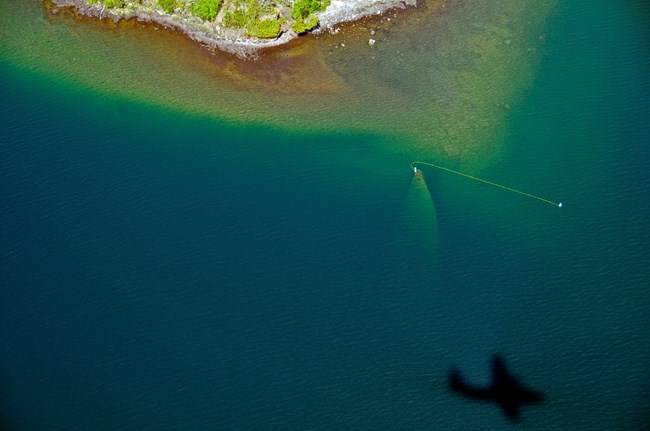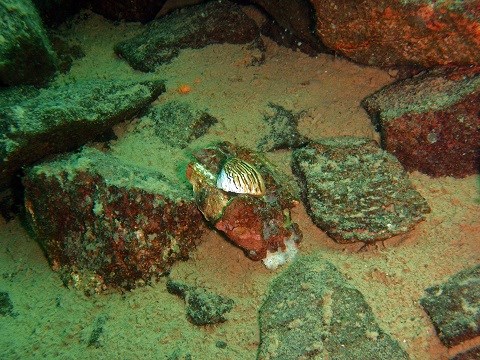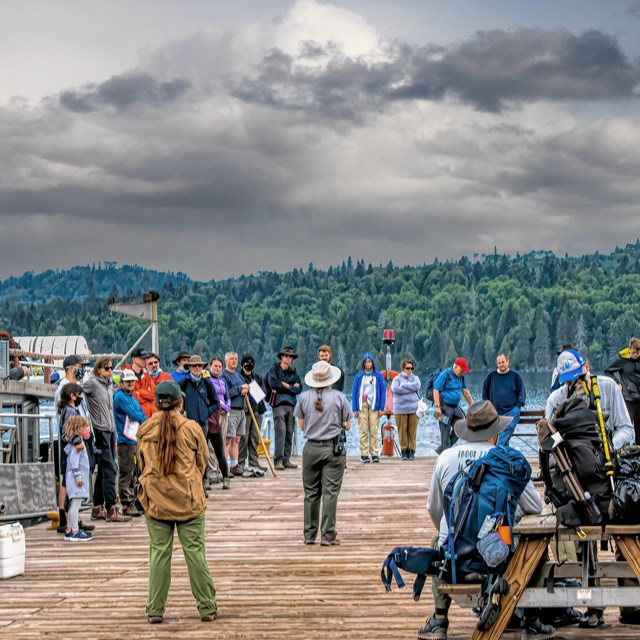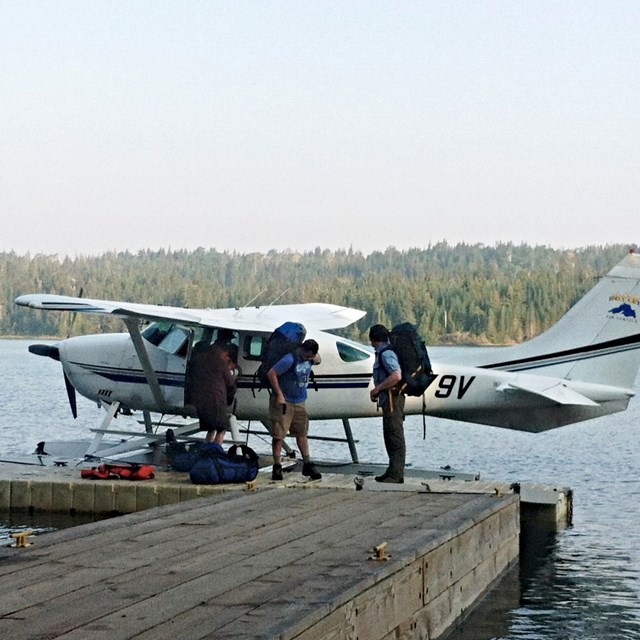Park EntranceAll visitors arriving by private seaplane need to check-in at an on-island visitor center. 
NPS photo / Paul Brown Regulations Regarding Flights Over Isle Royale National ParkDesignated Landing SitesAs articulated by the FAA's Aeronautical Information Manual at 7-4-6, the landing of aircraft is prohibited on lands or waters administered by the National Park Service without authorization. Exceptions include: 1) When forced to land due to an emergency beyond the control of the operator; 2) at officially designated landing sights, or 3) on approved official business of the Federal Government. The boundary of the park extends 4 1/2 miles into Lake Superior from the shoreline of Isle Royale. Fly Over Open WatersNinety-nine (99) percent of the land portion of the park is federally designated wilderness. The park requests that pilots attempt to conduct their flight operations over the open waters of Lake Superior rather than over the land, in order to minimize noise disruptions to wildlife and wilderness users. Minimum Altitude 2,000 FeetAll aircraft are requested to maintain a minimum altitude of 2,000 feet above the surface. FAA Advisory Circular 91-36D, Visual Flight Rules (VFR) Flight Near Noise-Sensitive Areas addresses the operation of aircraft over noise sensitive areas, including national parks. Pilots operating aircraft "should make every effort to fly not less than 2,000 feet above ground level (AGL), weather permitting." The advisory circular goes on to define the ground level of noise-sensitive areas as including "the highest terrain within 2,000 feet AGL laterally of the route of flight, or the uppermost rim of a canyon or valley." Airdrops ProhibitedFederal regulations also prohibit airdrops by parachute or other means of persons, cargo, or objects from aircraft within park boundaries. Exceptions include emergencies involving the safety of human life, or threat of serious property loss. Landing AreasBy Title 36 Code of Federal Regulations § 7.38, there are 3 Aircraft Designated Landing Areas at Isle Royale National Park: Tobin Harbor36 C.F.R. § 7.38(a)(1): Mott Island (Rock Harbor Channel)36 C.F.R. § 7.38(a)(2): Washington Harbor36 C.F.R. § 7.38(a)(3): Source: NPS DataStore Collection 9706. To search for additional information, visit the NPS DataStore. 
Photo courtesy of Mark Grey. Seaplane DockingSeaplane docking is permitted only at the NE end of Washington Harbor, Tobin Harbor immediately adjacent to the designated landing area, and at Mott Island.
Advance contact with the park is recommended. If aircraft is left unattended for longer than 24 hours, arrangements will need to be made with the Rock Harbor or Windigo District Ranger. FuelAviation fuel is not available anywhere on Isle Royale. Fly to the park with all fuel needed for your return flight. Operating SeasonIsle Royale National Park is open to the public from April 16 through October 31. Aircraft landing or other public use is prohibited between November 1 and April 15.CustomsCustoms clearance for private seaplane passengers is not available on Isle Royale. Private seaplaners flying to Isle Royale from Canada need to go to a mainland port of entry prior to arriving on-island. 
NPS photo / Paul Brown Aquatic Invasive SpeciesTraining for Self-InspectionA growing number of states are requiring that seaplane pilots be trained for self-inspection of aquatic invasive species. A quick, free online training system has been developed by the Washington Seaplane Pilots Association, in collaboration with the U.S. Fish & Wildlife Service, the National Seaplane Pilots Association, and the Washington Department of Fish & Wildlife to satisfy these requirements. It is recommended that any seaplane pilot flying to or from Isle Royale National Park hold a valid certificate of training. Local Invasive Species LawsIt is the responsibility of the pilot to be familiar with the laws pertaining to invasive species in all states and provinces that a seaplane is taking off from or landing in.

Logo produced by the U.S. Fish & Wildlife Service on behalf of the Aquatic Nuisance Species Task Force Stop Aquatic Hitchhikers!Tasked by Congress, the National Park Service is a member of the Aquatic Nuisance Species Task Force, an entity that has been responsible for developing the Stop Aquatic Hitchhikers national education campaign. Its guidance, at www.stopaquatichitchhikers.com, recommends the following for seaplane operators: At water take-off:
After water take-off:
DRY water from floats before take-off. DRY everything five days or more, unless otherwise required by local or state laws, when moving between waters to kill small species not easily seen OR wipe with a towel before reuse. Store aircraft on land when possible. Hot summer temperatures and flights during dry weather will help kill aquatic invasive plants and animals that may be on floats. Float Pumping, Decontamination, and InspectionPump into Sealed ContainerDo not pump any water from floats into any Isle Royale body of water. If you need to pump water from floats before taking off, dock the seaplane and and pump the water from the floats into a sealed container. Find an NPS ranger to help dispose of the water properly, down the drain to be processed by the park's wastewater treatment. During early or late season, if a ranger is unavailable and/or the wastewater system is not online, transfer the water at least 100 feet inland and dump onto dry soil to prevent any aquatic invasive species in the pumped water from entering the lake.DecontaminationAll seaplanes are subject to inspection for Aquatic Invasive Species at Isle Royale National Park. Seaplane operators are responsible for Aquatic Invasive Species decontamination prior to entering park waters.
|
Last updated: April 18, 2025



